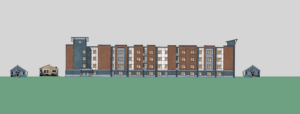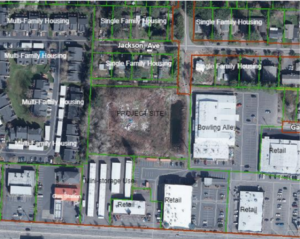Dispatch from West Olympia
People on Olympia’s Westside know Grocery Outlet and the Westside Lanes near the intersection of Harrison and Division. Residents know there’s a piece of vacant land next to Westside Lanes where a pedestrian path leads from Jackson Avenue NW to the shopping center.
In December 2020, Kyle Schrader and Taylor Wood (dba Crosswater Construction) bought that two-plus acres for a mere $75,000. They want to put a four-story building with 114 market rate apartments on the site, along with a 118-stall parking lot and 20 street stalls.


Problematic property
This property is unusual because it is located on the edge of a commercial zone (High Density Corridor 3) with commercial properties on two sides, and a residential zone (RM-18) on the north and west property lines. The lot is set quite far back, behind other businesses; it has no frontage on any commercial street.
As a commercial lot accessed through residential streets, it is an anomalous mismatch of zoning. Properties such as this should be zoned to match the zone through which they are accessed, so that the integrity of residential neighborhoods will be preserved.
Just route the traffic into the neighborhood
People who live in the neighborhood just north of the site have heard this story before. Nine years ago, another developer proposed a 6-story, 119-unit apartment building with traffic snaking in and out of the shopping center and feeding onto Harrison Avenue. Business people in the Westside Center objected to the creation of a traffic jam in front of their stores. Neighbors, community members and shopping center businesses worked together to defeat that project.
Kyle and Taylor have a proposal to “solve” the problem of a traffic jam on Harrison Avenue: drive traffic in and out of the Jackson Street neighborhood!
Olympia’s Community Planning and Development staff (CP&D) are moving this new proposal along. A design was submitted in June 2021. The Design Review Board approved it with the recommendation of City staff in early September. CP&D staff are in the process of reviewing documents and requesting revisions and conditions. The next major step is the Site Plan Review Committee, but nothing has been scheduled yet.
Constructing new streets, widening old ones
The Bing Street Apartment developers want to extend Bing Street, a tiny residential street, as the apartment’s sole access. Most traffic generated by the apartments would take Bing Street, travel down Jackson Avenue (a narrow residential “local access road”) then turn onto Division and finally Harrison Avenue.
The resulting traffic would far exceed the design capacity of Jackson Avenue, compromising the character and safety of our walkable neighborhood, in violation of the City’s own standards. Such a major traffic increase would make it nearly impossible for local residents to navigate Jackson Avenue. That would be true for residents of the proposed new apartments as well.
If community views don’t matter, supposedly the codes do
The “popularity” of a development, or how neighborhood residents may feel about it, is of no importance, according to City planners. What matters when communicating to the City about a project is whether a project violates its codes and standards—and this one does.
Olympia sets design standards for city streets based on average daily traffic volumes in their Engineering Design and Development Standards (See EDDS Chapter 4, Table 2 “Street Design Standards”). The stated purpose is to set standards required for safety, balanced with mobility of motor vehicles, bicyclists, pedestrians and transit riders.
Multifamily apartment buildings the size of the Bing Street Apts. are classified as commercial. The EDDS make clear that residential streets should not be used as the primary access for a commercial development (See EDDS 4I.080) The City’s standards recognize that this type of project is incompatible with residential streets, regardless of whether traffic volumes exceed design capacity.
A brief foray into street standards
Streets classified as “local access roads,” such as Jackson Avenue and Bing Street, are designed for a maximum of 500 trips per day on average (ADT). Using data from the developer’s traffic impact analysis, when the new traffic generated by the Bing Street Apartments is added to the existing traffic, the ADT for Jackson is projected as 632. Roads designed to carry more than 500 trips per day must be wider than Jackson Ave, with room for at least two driving lanes. Meeting the standard would require widening the City right-of-way into our front yards.
Neighborhood character and scale (1)
This building would be immediately adjacent on Bing Street to small single-family residences, which would be dwarfed by its size. Olympia’s Municipal Code includes a number of provisions intended to ensure multifamily developments fit in with the character of the neighborhood where they’re located (See OMC 18.170).
Olympia’s Design Review Board, however, decided to treat the building as connected to the bowling alley and shopping center rather than to the homes located on the street the building faces—this, despite the entrance being from the neighborhood. They therefore were satisfied that minimal changes would be sufficient for the building to fit in better with the residences in the neighborhood.
Promoting apartment construction downtown
Beginning several years ago, the City of Olympia offered generous property tax exemptions to the developers of a number of market rate apartment buildings downtown, all of which are looking for tenants. At 123 Fourth Avenue, modest two-bedroom apartments go for between $2200 and $2625 per month. Two-bedroom apartments in the Views on Fifth Tower rent for $4550. Most Olympians can’t afford these rents. Two-thirds of renters in Olympia have incomes below the “median” in the HUD calculations used by City planners. Over half of renters in Olympia pay more than 30% of their income on rent.
A boom in proposals for big apartment complexes in West Oly
Developers began eyeing the west side a few years ago. The proposed West Bay Yards would be a huge 478-unit complex consisting of five buildings on the shore of Budd Inlet. The Harrison Avenue Mixed Use Binding Site Plan for property next to the Bark and Garden Center proposes to subdivide a 7-acre parcel for restaurants, retail space and offices, and more market rate apartment buildings.
The Bing Street Apartments proposal is yet another apartment complex whose units will be offered at market rates, leaving out low- and middle-income renters and adding to the glut of apartments too expensive to fill.
Who benefits
Approving Crosswater’s Bing Street Apartments would create a massive headache for the surrounding neighborhood. Jackson Avenue simply wasn’t built to accommodate the projected volume of traffic. The apartments will not mean more housing for working people. The only ones who will benefit from this project are Kyle Schrader and Taylor Wood of Crosswater Construction.
Carolyn Roos lives in West Olympia and researched Olympia’s codes and standards when the proposal for a six-story apartment on Bing Street was under consideration in 2011.
To comment on the proposalContact Olympia city planner Paula Smith with questions and comments. Request to be made a “party of record” so the city will keep you informed. The permit number for the project is 21-2960. Write the mayor and city council members. Urge them to ensure the City manager directs staff to enforce Olympia’s Engineering Design Standards and not approve projects that violate design standards for city streets. Get in contact with neighbors by emailing BuildGoodNeighbors@nwlink.com. |

Be First to Comment